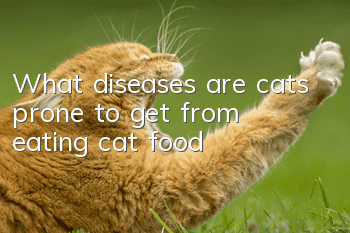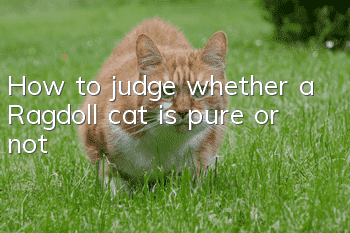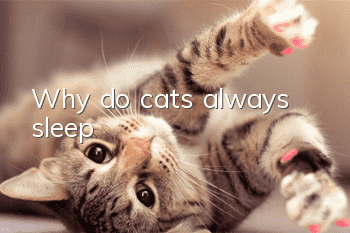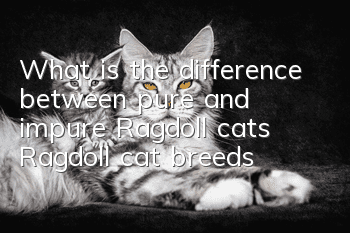What diseases are cats prone to get from eating cat food?

Nowadays, many feline diseases are treated with drugs, but the effects are often mediocre. At the beginning of treating the disease, many doctors ignore an important fact - the source of the disease is likely to be daily food.
According to statistics, in the past 20 years, the actual average life span of cats has decreased from more than 20 years to less than 10 years now. Indoor cats, especially those whose owners we love so much, should easily live into their 20s.
You know, before the "cat food revolution" of the last century began, people in their 20s were just an average.
The most likely culprit for certain diseases, such as diabetes, is carbohydrate-filled dry cat food, a product of the "cat food revolution." Some other unexplained diseases may also be attributed to this.
First of all, the cat diseases mentioned below refer to primary (no known cause) and conditions directly attributed to high-carbohydrate dry food. Other factors, such as cancer, allergens, etc., may also be the cause of kidney and urinary system problems, which are secondary or definite causes. Not included in the scope of discussion below.
In addition, there are many benefits to switching diets.
But for cats that already suffer from specific diseases, you must consult a veterinarian before switching to raw meat, otherwise there will be side effects.
Primary: Primary is relative to secondary and metastatic. That is to say, if a certain disease first occurs in a certain tissue or organ, the disease is primary to that tissue or organ. For example: primary hepatocellular carcinoma means that liver cells first become cancerous, while secondary liver cancer means cancer in other parts of the body that metastasizes to the liver through the blood flow or lymphatic pathways. The primary site is in other tissues or organs. rather than the liver.
1
Dental disease
Many cat food manufacturers promote that when cats chew cat food, the cat food will scratch their teeth, thus cleaning their teeth. However, there is no scientific evidence to support the above claims.
After the cat food is imported, the cat food may be crushed only when the tips of the canine teeth contact the cat food. During this process, other teeth did not scratch the cat food.
Moreover, long-term observation has found that most cats swallow cat food directly.
Although swallowed, dry food will still leave starch residue in the mouth and teeth, which can lead to tooth decay and gum disease over time. Unlike omnivores (e.g. humans, dogs), cats’ mouths containThere is amylase, so it cannot break down the remaining carbohydrates.
Some so-called "tartar control" prescription foods contain fiber substances that are difficult for cats to digest, which will put additional pressure on the cat's digestive system.
Raw meat and meat with bones can really clean your teeth to a certain extent. Because when a cat bites, the meat (or bones) will scratch the cat's teeth, which is indirectly equivalent to brushing its teeth.
But small cats, such as domestic cats, are less likely to reject larger bones (such as chicken bones). Because their natural prey are usually smaller, such as mice, birds, insects, lizards, etc., and the bones of these prey are usually smaller.
In addition, the acidity in the meat diet inhibits the growth of bacteria. Cat saliva also contains lysozyme. When bacteria enter the mouth, it will start to digest (kill) the bacteria. Therefore, there is no need to worry too much about bacteria in raw meat and bones.
Regarding the issue of dry food and oral cavity, you can refer to my other translation article "What does dry cat food do to cats' teeth?"
2
Stomatitis and tooth resorption
Stomatitis in cats is very common. This disease is very painful and can be life-threatening in severe cases.
Cats with stomatitis usually have bad breath, red, swollen and inflamed gums. Over time, the inflammation will spread to adjacent teeth and even the deep throat. For such cats, eating and swallowing will become difficult and painful.
The cause of stomatitis is not yet clear. It may be related to FIV (feline AIDS) and FCV (cup body). It may also be related to diet.
Many cats with stomatitis also suffer from tooth resorption. Inflamed gums may appear to be "growing into" a tooth, or a tooth may appear to have a cavity. Tooth resorption is usually treated surgically.
The cause of dental resorptions (FORLs) is currently unknown. It can be complicated. The incidence of this disease has been increasing year by year in recent years. The emergence of commercial cat food has led to changes in cats’ dietary structure and nutritional structure. No cat food manufacturer is willing to explore the relationship between this.
Reference article "Destructive resorption damage of cats' teeth (tooth resorption) - FORLs"
Supporters of raw meat and bones believe that by switching to a diet based on raw meat and bones, oral diseases will be relieved for a long time and will not lead to surgery.
3
Obesity
When a cat eats a high-carbohydrate diet, its pancreas releases more insulin, which can cause hypoglycemia, causing the cat to feel hungry and need more food.
In addition, with a low animal-based protein diet, the cat cannot down-regulate liver enzymes, which will also cause hunger and require it to eat more food to meet its protein needs.
The above cycle of constant "eating, eating, eating" will lead to the accumulation of fat in the cat's body, leading to obesity (energy consumption exceeds intake).
Cats break down protein and fat as energy sources, and their ability to directly utilize carbohydrates is very limited. Excess carbohydrates in the body will be converted into fat.
This is the reason why many cats who have been eating dry food for a long time look fat, but they are "swollen" and not strong.
A cat's body shape should be toned, with well-defined shoulders, chest, and waist. The ribs should have a thin covering of muscle and fat that can be easily felt with your fingers.
The weight of an average-sized adult cat should be between 3.2 - 5.5 kg
A large adult cat should weigh between 5.5 - 8.2 kg
Domestic cats in the United States today are generally overweight or obese.
When feeding raw meat and bones, cats will consume more high-quality animal-based protein. Cats’ bodies are very suitable for this kind of diet. After they are full, they will not eat anymore and will not feel hungry constantly.
On the contrary, feeding cats dry food will make them hungry all the time. For details on this part, please refer to my other translation "Common Problem: The Effect of Cat Dry Food on Appetite and Weight - "The Fatter, the Hungry""
A long-term dry food-based diet, in addition to obesity, can also lead to type II diabetes. Additionally, obesity can lead to reduced activity, weight gain, dry and loss of coat, and an inability to self-groom, which can lead to infection. Arthritis and depression are also relatively common.
So-called "weight-modifying" prescription foods often remove some of the fat and increase the fiber and carbohydrate content of the food. Cats already have insufficient protein intake from normal dry food. Such a so-called "prescription" diet will further lead to constant hunger, malnutrition and long-term dehydration. High fiber can also cause constipation.
Therefore, this type of prescription food is not so much "prescription food" as "execution food".
Cats who switch to a high-meat-based protein, moderate-fat, low-carbohydrate, grain-free canned or raw diet will experience immediate relief from obesity or overweight, and these cats will begin to lose weight even without increased activity.
As weight is lost, the cat will in turn increase its activity level.
As mentioned above, when it comes to eating meat, cats usually have no idea (self-limiting) and will not eat it all the time, thus maintaining an appropriate intake.
4
Daily energy intake and weight loss monitoring
Calorie intake
The units used below are imperial units: 1 ounce = 28.35g 1 pound = 0.454kg
The prescribed daily consumption on any cat food package is excessive for most cats, and eating so much will only lead to obesity.
The appropriate intake should be calculated based on various factors such as gender, size, activity level, life stage, etc.
The formula given below is an approximation. Slightly adjust the amount you actually feed to maintain the cat's ideal weight and condition.
If a 12-pound cat wants to maintain its current weight:
(13.6 calories × 12 pounds) + 70 = 233 calories / day
Cats who switch to a high-meat-based protein, moderate-fat, low-carbohydrate, grain-free canned or raw diet will experience immediate relief from obesity or overweight, and these cats will begin to lose weight even without increased activity. As weight is lost, the cat will in turn increase its activity level.
If a 16-pound cat wants to lose weight to 12 pounds:
Minimum daily intake: 12 pounds × 15 calories = 180 calories
Based on average calorie content, a 180-calorie serving of canned or raw food is roughly between 4 and 5 ounces.
Lose weight
If your cat is losing weight, make sure she loses no more than 1-2% of her body weight per week
If you are losing weight too quickly, feed more. Adding some raw or cooked chicken will also help increase the protein level of your food without adding too much fat. Keep the addition of chicken to less than 10% of your daily caloric intake.
The following calculations are based on a cat weighing 12 pounds.
First convert the unit: 12 pounds = 192 ouncesDivision
Weekly weight loss: 192 × 1% - 192 × 2%, which is 1.9 - 3.8 ounces
In other words, a 12-pound cat should lose between 1.9 and 3.8 ounces per week.
To monitor your weight, purchase an electronic baby scale and weigh yourself twice a week during the early stages of weight loss, and several times a year thereafter.
It is important to monitor weight loss, especially in cats that are overweight or obese. If you lose weight too quickly, your cat may stop eating, causing fat to accumulate in the liver (fatty liver disease).
5
Fatty liver
If your cat loses weight quickly or stops eating, he may develop fatty liver disease.
Some cases have no known cause, however, most are related to anorexia. When a cat doesn't eat, the body will release a large amount of fat, which will be transported to the liver, stay on the liver, block the liver, and cause the liver to no longer function properly.
The cat may eat little or nothing at this time. Treatment usually requires intubation feeding.
6
Diabetes
As mentioned above, when a cat eats a high-carbohydrate diet, the pancreas will release more insulin, but it may still not be enough to metabolize all the carbohydrates in the body.
Hyperglycemia manifests as high blood sugar, increased thirst and urine output, and over time symptoms such as hunger, weight loss, vomiting, dehydration, and lethargy will appear.
Usually, daily injections of insulin are required. However, in many cats, insulin does not seem to control diabetes and blood sugar fluctuations well.
So-called "prescription" diets often add indigestible amounts of fiber to prevent sugar from being absorbed into the bloodstream. However, it doesn't seem to work.
High-fiber diets often lead to constipation, increased stool volume, and blood sugar levels that remain high.
Because this diet is usually not suitable for cats, pet food companies add food attractants to attract cats to eat. A high-carbohydrate diet can cause cats to crave protein, leading to worse outcomes.
Obesity is a common problem with diabetes. However, not all obese cats are diabetic cats, and not all diabetic cats are obese cats.
Corn is one of the main ingredients in many cat foods. However, corn can cause highblood sugar levels because it has a high glycemic index (carbohydrates are ranked according to their effect on blood sugar levels).
If a diabetic cat is switched to a high-meat-based protein, moderate-fat, low-carbohydrate, grain-free canned or raw diet, insulin injections are usually no longer needed.
For those cats who still require insulin, the dose will also be reduced.
The plan to change the diet needs to be discussed with the veterinarian, and blood sugar testing should be performed. For more detailed information, please refer to the article "Must-read if you have an old cat at home: The culprit of diabetes (and control and treatment)"
7
Urinary system problems
Urinary system problems, also known as cystitis/FUS/FLUTD (feline lower urinary system disease), may cause symptoms, such as inability to urinate, blood in the urine, etc.
This disease is very painful and must be treated with painkillers. If your cat has difficulty urinating, especially if he is unable to urinate (auria), then his condition is critical. Go to the vet immediately for a catheterization!
Many times, these affected cats have blood in their urine, usually as a result of irritation (and inflammation) of the bladder mucosa from uroliths (crystals or stones).
It is rare for cats to actually have a urinary tract infection (bacterial infection). The only way to diagnose an infection is to perform a culture and sensitivity test, which first grows the bacteria to identify the infection and then tests which antibiotic is effective against the infection.
Usually, however, it is primary, that is, spontaneous cystitis. The cause is most likely dry food and malnutrition.
Cats evolved as pets in the desert and get most of their water from their prey. This, combined with their low thirst drive, can cause them to remain in a chronic state of mild dehydration.
Dry food is low in moisture, which forces the kidneys to concentrate the urine to maximize water retention, alleviating the body's need for water. This concentrated urine contains minerals such as magnesium, ammonium, and phosphorus, which are the building blocks of struvite crystals. In turn, struvite crystals may form, leading to urinary tract obstruction and death.
When urinary tract problems became common, pet food companies realized that the urine produced by these dry, carbohydrate-rich foods was alkaline, a result of sugar metabolism. This is also an ideal environment for growing struvite crystals.
To solve this problem, pet food companies choose to add acidifiers to the food to lower the pH of the urine, usually DL-methionine or ammonium chloride.
They also believe that reducing the magnesium content is a good idea because if magnesium is not present, crystals will not form. This whole mindset is wrong, kind ofIf you have a headache, treat your head. If your feet hurt, treat your feet.
Remember, magnesium is a key nutrient for cats in building bones and teeth, as well as other metabolic activities.
Over the next decade or so, struvite crystals decrease and calcium oxalate stones increase.
Calcium oxalate stones grow in a highly acidic environment. An increase in calcium oxalate stones has also been associated with idiopathic hypercalcemia and chronic acidosis.
Acidification of the diet causes (at least in some cases) the loss of calcium from the bones, which is then deposited in soft tissues.
Calcium oxalate stones are also found in the kidneys and bladder. Calcium oxalate stones can only be removed through surgery and there is no other way.
Due to the smaller diameter of the urethra, male cats are prone to urinary system problems. Urinary tract problems will continue to reoccur throughout a cat's life if they continue to eat those so-called prescription foods.
A wet diet is necessary for any cat with urinary problems.
These cats should no longer eat any dry food.
Interestingly, meat protein produces slightly acidic urine (pH 6.5), which is the natural pH of cat urine and also provides the higher magnesium levels cats require.
8
Primary hypercalcemia
Idiopathic hypercalcemia (too much total calcium and too much ionized calcium) may be caused by an acidifying, low-magnesium diet.
Ironically, the diagnosis rate of this disease has become higher and higher with the emergence of prescription foods for the urinary system. It usually affects young to middle-aged cats and is often difficult to recognize clinically because cats with kidney disease also have high blood calcium levels.
Kidney failure causes hypercalcemia, which in turn causes kidney failure, and it's often not known which comes first.
DL - Methionine is an acidulant commonly used in many dry foods and can also be found in some cans. Many veterinarians have questioned the potential adverse effects of this chronic acidification process on kidney and bone development if consumed for a long time.
In addition, the potassium content of the diet may be important because chronic metabolic acidosis may lead to potassium deficiency and thus renal dysfunction. Prescription foods for the urinary system are also often low in magnesium, which is important for the binding of calcium to bones.
There is evidence that a diet high in meat protein, such as canned or raw meat, may help relieve symptoms.
9
Chronic kidney disease
Most cats do not develop chronic kidney disease (CRD) until more than 70% of their kidneys are no longer functioning properly.
Symptoms include: thirst, increased urination, loss of appetite, lethargy, weight loss, muscle atrophy, dull coat, and vomiting of food or bile.
If the cause is found, such as poisoning, acute kidney disease can be treated and cured.
Chronic kidney disease is a terminal disease that can also appear in kittens. If there is no known cause, such as a tumor or related disease, nutritional and water intake may be the culprit.
There is some indication that acidosis from an acidic diet may also lead to renal failure or hypercalcemia in otherwise healthy cats.
When a cat is diagnosed with chronic renal failure, some veterinarians will immediately recommend prescription foods. These prescription foods claim to be low in protein and low in phosphorus to reduce the pressure on the kidneys in metabolizing protein.
However, as mentioned previously, there is no scientific evidence to support this hypothesis.
In fact, feeding an obligate carnivore a diet very low in protein will cause more muscle and organ weakness.
The body metabolites of an obligate carnivore crave something more meaningful: a diet high in meat protein.
Phosphorus reduction may be necessary but can be achieved by adding phosphate binders to foods. Another option is to add chopped cooked egg whites, thereby increasing protein levels without increasing phosphorus levels, since egg whites contain very little phosphorus.
A liver chemistry test used to diagnose chronic renal failure is the urea nitrogen (BUN) test.
Typically, when this number exceeds the reference range, it's a clear sign that other factors are contributing to kidney disease as well. However, BUN is a nontoxic byproduct of protein metabolism.
In fact, some cats fed a high-meat protein diet have blood urea nitrogen levels that are naturally higher than the laboratory's safe range.
10
Inflammatory bowel disease
IBD (inflammatory bowel disease) is an immune-related disease characterized by chronic vomiting, diarrhea, and digestive abnormalities.
Food is the most obvious allergen that causes these problems.
In response to this problem, pet food manufacturers have produced hypoallergenic foods, often containing foods such as lamb and rice (fish and beef are common allergens in cats).
However, other ingredients in these prescription foods, including carbohydrates, vegetables, fruits, etc., can still cause adverse reactions. Typically, thesePrescription food won't help.
In these cases, raw food is the only option.
- What to do if a cat gets ringworm? How to treat ringworm in kittens
- Is there any way to prevent Ragdoll cats from losing hair? Teach you the solution!
- Why are cats afraid of orange peels?
- What does it mean when a cat licks a person's face and hands?
- How to tell if your cat has fleas?
- Why do orange cats have tear stains? Is it normal for a three-month-old orange cat to have severe tear stains?
- What foods should cats absolutely not eat?
- What kind of nutritious milk powder can a cat drink after giving birth?
- What should I do if my kitten is infected with a skin disease? Common skin diseases in kittens
- How to reduce stress when taking your cat out



